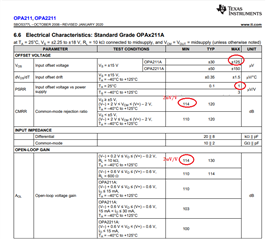Other Parts Discussed in Thread: OPA1622
Hi,
In reading the document "An Engineer's Guide to Designing with Precision Amplifiers" a question has come up regarding the contribution to input offset voltage made by the PSRR of the device.
On page 10, section "How to interpret an op amp’s offset voltage specification and test conditions", the input offset voltage for the OPA211 device is discussed. The OPA211 data sheet does not specify input offset voltage over a range of supply voltages; rather, it specifies it at a single operating voltage of +/-15V. Further down, below figure 4, the document says: "Changing the supply voltage of the OPA211 from ±15 V to ±10 V introduces an additional offset voltage because of the device’s PSRR specification (±1 µV/V)" and equation 1 then shows that this additional offset voltage is +/-10uV. The additional offset voltage is then added to the initial (data sheet value at +/-15V) offset voltage to obtain the worst case offset voltage.
Now, this is referring to DC input offset and the implication is that, as you decrease the operating voltage below +/-15V (decrease magnitude), the input offset voltage worsens (increases magnitude). This is hard for me to digest as it is counter-intuitive. Take a different device, for example, the OPA1622. Here, the data sheet specifies the average (+/-100uV) and maximum offset voltage (+/-500uV) over an operating voltage range +/-2V to +/-18V. So we can be sure (to a 3 sigma probability) that at any operating voltage within the specified range, the offset voltage will not exceed +/-500uV. An alternative way of phrasing this for the OPA1622 is that, at DC, the contribution to the offset voltage made by the device PSRR is zero.
Back to the OPA211, the combination of a single data sheet value for offset voltage taken together with the discussion in the document, would mean that the offset voltage value specified at +/-15V is the best case possible; any deviation from that operating voltage will increase the magnitude of the offset voltage with the worst case being at the lowest operating voltage (+/-2.25V, 150.5uV offset voltage).
Is this the right way to interpret the data sheet data?
Regards,
AC



